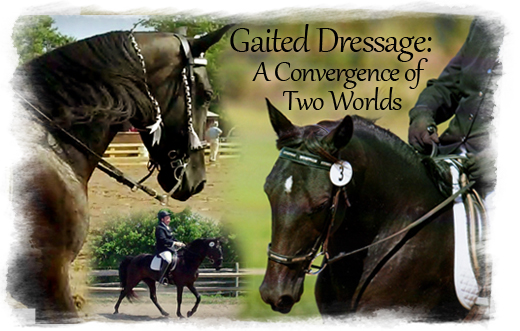There’s a convergence in gaited dressage: the traditional dressage rider who later applies what they know to riding gaited horses and the traditional gaited horse rider who later learns dressage methods of training.
The former describes me, and I can’t ride my gaited horse well without learning from the latter. Each paradigm offers unique perspectives about what is “correct.” I believe gaited dressage has an equation: “both” + “neither” = “correct.” Both perspectives add value to this equation. Neither perspective holds the fullness of “correct.” Yet one perspective without the other is only half the gaited dressage equation.
Riders like me who have spent decades studying dressage on trotting horses understand the importance of balance, impulsion, engagement, relaxation, harmony, softness, suppleness, bending to develop the full range of walks, trots, and canters equally in both directions and produce an ambidextrous horse.
When I bought my first gaited horse, dressage was the only language I knew. However, what is “correct” on a trotting horse is not the same as what is “correct” on a smooth-gaited horse. The flatwalk and running walk have a distinctly different “feel” than that of a trot and lengthening. Riding a head-shaking horse on-the-bit has a distinctly different “feel” as compared with a trotting horse. I’ve needed the perspective of knowledgeable gaited riders to help me develop “correct feel.” And I’m still learning.
On the other hand, there are gaited riders who are new to this concept of dressage. They know how to ride a head-shaking horse in a shank bit and need to learn a new means of communication through a snaffle bit. They know how to keep their gaited horse in a consistent four-beat gait along the rail, yet need to learn the concept of the inside leg to outside rein to establish bend and balance in the gait through circles, lateral exercises, and to develop the full range of walks, easy gaits, and canters on both reins, precisely on the letter. It takes the perspective of a knowledgeable dressage rider to learn this.
Riding a gaited horse consistently well is challenging and dressage is challenging no matter how many years you’ve been at it. The goal for me is not perfection, rather improvement. Dressage is a journey, not a destination. So be part of the equation; you’ve got something to offer the other half!

